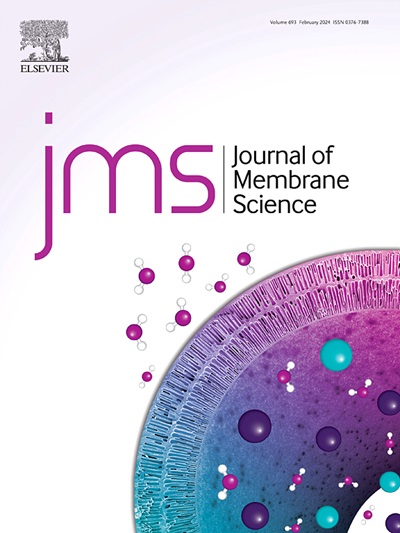Advancing membrane carbon capture in liquefied natural gas-fueled ships via upper bound theory and multi-objective optimization for CO2/O2 separation
IF 8.4
1区 工程技术
Q1 ENGINEERING, CHEMICAL
引用次数: 0
Abstract
The commitment of the shipping industry to reduce greenhouse gas emissions has spurred interest in onboard carbon capture solutions for liquefied natural gas (LNG)-fueled ships, which generate exhaust with low CO2 and high O2 contents. Membrane-based carbon capture is a promising alternative to bulky amine scrubbing. However, the critical challenge of CO2/O2 separation in O2-rich exhaust has been largely overlooked in prior studies. Herein, we leveraged the upper bound theory to evaluate the performance of advanced membrane materials for a CO2/O2 gas pair, thus integrating this into a multi-objective optimization framework for system design. New CO2/O2 upper bound correlations were derived from established CO2/N2 and O2/N2 relationships to define several performance scenarios for next-generation membranes. Pareto optimization was then applied to identify the optimal trade-offs between the specific energy consumption (SEC) and membrane area. The results demonstrated a clear SEC–area trade-off: achieving an ultralow SEC required large membrane areas, whereas smaller membrane systems incurred higher SEC. Improving CO2/O2 selectivity emerged as a pivotal factor. In an upper bound analysis, membranes approaching to the current CO2/O2 performance limits achieved SEC values of approximately 3.5 GJ/ton LCO2. Only a highly selective hypothetical membrane (CO2/O2 selectivity ≈ 20, roughly double of the current values) reduced the SEC to <3.15 GJ/ton. This performance surpassed that of the conventional amine-based capture systems and met stringent energy targets. These findings underscore the novelty of combining upper bound material insights with process optimization. We identified specific membrane performance targets required for efficient shipboard CO2 capture to guide future membrane development for maritime carbon capture applications.

基于上限理论和CO2/O2分离多目标优化的液化天然气燃料船舶膜碳捕集技术
航运业致力于减少温室气体排放,这激发了人们对液化天然气(LNG)燃料船舶的船上碳捕集解决方案的兴趣,液化天然气(LNG)燃料船舶产生的废气二氧化碳含量低,氧气含量高。膜基碳捕获是一种有前途的替代大体积胺洗涤。然而,在以前的研究中,富氧废气中CO2/O2分离的关键挑战在很大程度上被忽视了。在此,我们利用上界理论来评估用于CO2/O2气体对的先进膜材料的性能,从而将其整合到系统设计的多目标优化框架中。从CO2/N2和O2/N2关系中推导出新的CO2/O2上界相关性,以确定下一代膜的几种性能场景。然后应用帕累托优化来确定比能量消耗(SEC)和膜面积之间的最佳权衡。结果表明了明显的SEC面积权衡:实现超低SEC需要大的膜面积,而较小的膜系统则需要更高的SEC。提高CO2/O2选择性成为关键因素。在上限分析中,接近当前CO2/O2性能极限的膜的SEC值约为3.5 GJ/吨LCO2。只有高选择性的假设膜(CO2/O2选择性≈20,大约是当前值的两倍)将SEC降低到3.15 GJ/吨。这一性能超过了传统的胺基捕获系统,并达到了严格的能源目标。这些发现强调了将上界材料见解与工艺优化相结合的新颖性。我们确定了有效的船上二氧化碳捕获所需的特定膜性能目标,以指导未来用于海上碳捕获应用的膜开发。
本文章由计算机程序翻译,如有差异,请以英文原文为准。
求助全文
约1分钟内获得全文
求助全文
来源期刊

Journal of Membrane Science
工程技术-高分子科学
CiteScore
17.10
自引率
17.90%
发文量
1031
审稿时长
2.5 months
期刊介绍:
The Journal of Membrane Science is a publication that focuses on membrane systems and is aimed at academic and industrial chemists, chemical engineers, materials scientists, and membranologists. It publishes original research and reviews on various aspects of membrane transport, membrane formation/structure, fouling, module/process design, and processes/applications. The journal primarily focuses on the structure, function, and performance of non-biological membranes but also includes papers that relate to biological membranes. The Journal of Membrane Science publishes Full Text Papers, State-of-the-Art Reviews, Letters to the Editor, and Perspectives.
 求助内容:
求助内容: 应助结果提醒方式:
应助结果提醒方式:


